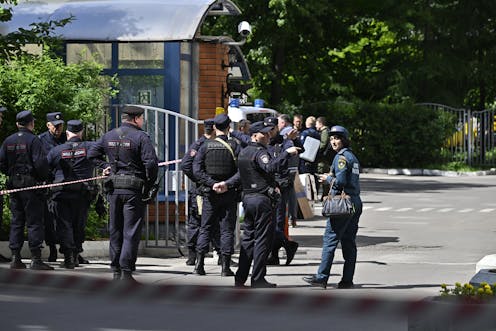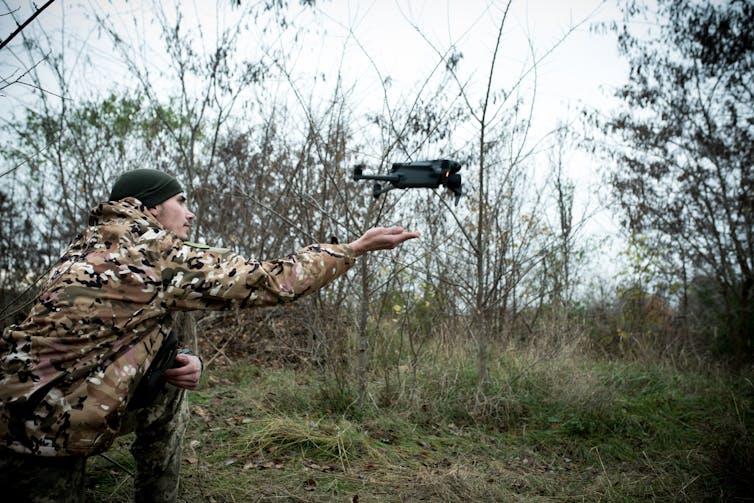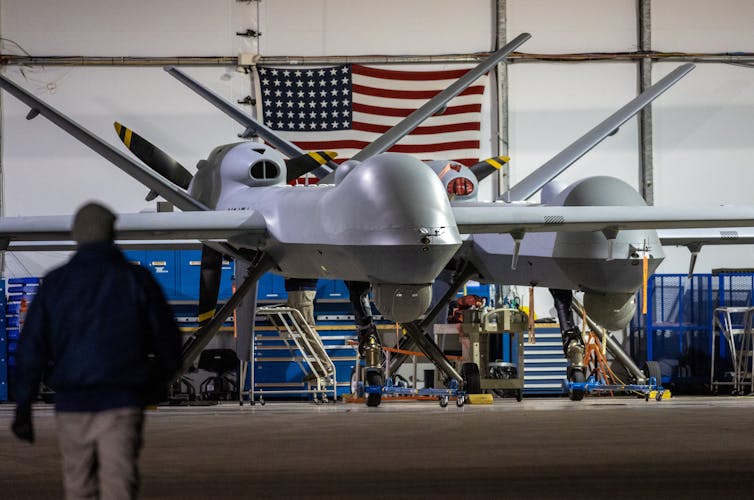Drone strikes hit Moscow and Kyiv -- in the growing world of drone warfare, anything goes when it co
As drone strikes become a more routine part of warfare, a set of rules or standards that can help determine how they are used in warfare is needed, writes a former US diplomat.

At least eight drone strikes hit Moscow in the early morning of May 30, 2023, damaging several buildings and injuring civilians.
This follows Russia’s targeting residential buildings in Ukraine with a wave of drone attacks in late May, killing civilians.
While Ukraine has said it is not “directly” responsible for the strikes on Moscow, Russia’s government has called the strikes a “terrorist attack.”
For more than a year, daily life in Ukraine has been marked by aerial vehicles known as drones littering the sky, creating unease and inflicting real damage in the war with Russia.
Both Russia and Ukraine are using drones in this war to remotely locate targets and drop bombs, among other purposes.
Today, drones are used in various other conflicts but are also used to deliver packages, track weather and entertain drone hobbyists.
Military drones range from small consumer quadcopters to remotely piloted warplanes – and all types are being used by militaries around the world.
As a scholar of public diplomacy and foreign policy – and a former United States undersecretary of state for public diplomacy and public affairs – I know how important it is for people to understand drones and their proliferation, given the risks of war, terrorism and accidental drone clashes in the world today.

A buying spree
The U.S. is among more than 100 countries using drones in times of conflict.
Terrorists have also been known to deploy drones because they are relatively low-cost weapons with high degrees of civilian damage.
Consumer drone shipments, globally, topped 5 million units in 2020 and are expected to surpass 7 million by 2025.
Sales of drones globally were up 57% from 2021 to 2022.
With the exponential rise in drone purchases over the last few years, there are few constraints for buyers, creating a wild, wild west of uncontrolled access and usage.
Each country is free to decide when and where drones fly, without answering to any other country or international authority governing drones. There is little on-the-ground guidance on the rules of the sky.
Different purposes
Each country has a unique interest in getting and using drones.
China is increasingly using sophisticated drones for covert surveillance, especially in international waters to patrol the disputed islands in the South China Sea. Its expanding drone program has influenced other countries like the U.S. to also invest more in the technology.
Turkey’s military has a highly sophisticated drone, the Bayraktar TB2, which is capable of carrying laser-guided bombs and small enough to fit in a flatbed truck.
The United Arab Emirates imports drones from China and Turkey to deploy in Yemen and Libya to monitor warlords in case conflict breaks out.
And South Korea is considering starting a special drone unit after it failed to respond to a recent North Korean drone incursion. When North Korea deployed five drones toward its southern neighbor in December 2022, South Korea had to scramble its fighter jets to issue warning shots.
No rules in the air
The countries with armed drones are individually navigating their own rules instead of an international agreed-upon set of regulations.
International law prohibits the use of armed force unless the United Nations Security Council authorizes an attack, or in the case of self-defense.
But short of launching a full war, drones can legally be deployed for counterterrorism operations, surveillance and other non-self-defense needs, creating a slippery slope to military conflict.
Figuring out the national and international rules of the sky for drone usage is hard.
For 20 years, experts have tried to create international agreements on arms – and some countries supported an informal 2016 U.N. agreement that recommends countries document the import and export of unmanned aerial vehicles.
But these efforts never evolved into serious, comprehensive standards and laws that kept pace with technology. There are several reasons for that. In order protect their national sovereignty, governments do not want to release drone data. They also want to avoid duplication of their technology and to maintain their market share of the drone trade.

US and drones
The U.S. has wrestled with how to balance drone warfare as it became involved in overseas operations in Iraq, Afghanistan, Syria and other conflict zones.
The U.S. killed a top al-Qaida leader with a drone strike in Afghanistan in 2022.
But there have been other instances of drone strikes that resulted in unintended casualties and damage.
In 2021, The New York Times reported that a U.S. drone strike on a vehicle thought to contain an Islamic State bomb resulted in the deaths of 10 children – not three civilians, as the U.S. said might have happened.
There is scant public opinion research on how American feel about the use of drones overseas, which makes building public support for their military use difficult.
Drone dangers
Drone dangers are real.
Many drone experts, including myself, believe it is unsafe for each country’s military to make its own decisions on drones with no rules guiding drone transfers, exports, imports and usage – and no major forum to discuss drones, as the technology continues to evolve.
Multiple drones can communicate with each other remotely, creating shared objectives rather than an individual drone path or pattern. Like a swarm of bees, these drones form a deadly and autonomous aerial army ripe for accidents.
With the advent of artificial intelligence and more sophisticated unmanned aerial vehicles, drones can change speed, altitude and targeting in seconds, making them even more difficult to track and investigate. Attacks can happen seemingly out of the blue.
Drone detection is another complication, especially on the battlefield.
Ukrainian and Russian forces each want to know exactly where a drone originated. That can be difficult to determine, especially at night, as drones are fast-moving vehicles. Traditional radar detection has grown more sophisticated with new drone detection platforms to more accurately decipher the exact location of the drone operator.
In my view, the world needs new and consistent rules on drone usage for the decade ahead – better international monitoring of drone incursions and more transparency in the outcome of drone attacks.
This is an updated version of an article originally published on May 19, 2023.
Tara Sonenshine does not work for, consult, own shares in or receive funding from any company or organization that would benefit from this article, and has disclosed no relevant affiliations beyond their academic appointment.
Read These Next
From truce in the trenches to cocktails at the consulate: How Christmas diplomacy seeks to exploit s
World leaders like to talk up peace at Christmastime. But alongside the tales of seasonal breaks in…
Autocracies in transition: In 2025, Cameroon and Tanzania rulers clung to power — but look more vuln
The countries, whose respective leaders recently won widely disputed elections, offer contrasting examples…
Why are some Black conservatives drawn to Nick Fuentes?
Black Americans and white nationalists have joined forces in the past. And a number of cultural and…






